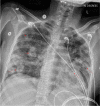Candida dubliniensis Fungemia Leading to Infective Endocarditis and Septic Pulmonary Emboli
- PMID: 37323365
- PMCID: PMC10266299
- DOI: 10.7759/cureus.39031
Candida dubliniensis Fungemia Leading to Infective Endocarditis and Septic Pulmonary Emboli
Abstract
Illicit drugs, especially those injected intravenously, are becoming increasingly more common worldwide. Individuals who use intravenous drugs often reuse or share needles which predisposes them to life-threatening infections. We present the case of a patient who was injecting intravenous drugs into her internal jugular vein, which eventually led to acutely worsening sepsis secondary to fungal infective endocarditis and bilateral septic pulmonary emboli. Transthoracic echocardiogram demonstrated multilobulated and spherical vegetations on the tricuspid and mitral valves, respectively. On computed tomography of the thorax, numerous cavitary lesions and ground-glass opacities were present in both lungs. Multiple hyperdense, linear structures consistent with broken needles were seen on chest radiography. It is important for radiologists to recognize the possibility of broken needles in patients with a history of intravenous drug use as astute recognition of broken needles may lead to better source control and improved outcomes.
Keywords: broken needle fragments; candida dubliniensis; computed tomography (ct) imaging; fungemia; infective endocarditis.
Copyright © 2023, Jafroodifar et al.
Conflict of interest statement
The authors have declared that no competing interests exist.
Figures







References
-
- United Nations on Drugs and Crime. Prevalence-general. Published. [ May; 2023 ]. 2021. https://dataunodc.un.org/data/drugs/Prevalence-general https://dataunodc.un.org/data/drugs/Prevalence-general
-
- United Nations on Drugs and Crime. People Who Inject Drugs. Published. [ May; 2023 ]. 2021. https://dataunodc.un.org/data/drugs/People Injucting drugs https://dataunodc.un.org/data/drugs/People Injucting drugs
-
- Injection drug use and HIV/AIDS transmission in China. Chu TX, Levy JA. Cell Res. 2005;15:865–869. - PubMed
-
- Intravenous drug users and broken needles--a hidden risk? Norfolk GA, Gray SF. Addiction. 2003;98:1163–1166. - PubMed
Publication types
LinkOut - more resources
Full Text Sources
